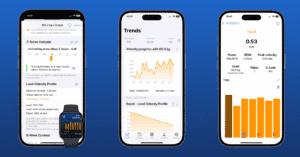In the world of strength and power training, peak velocity performance stands as a critical metric, representing the maximum velocity achieved during a movement or lift. With Spleeft, an innovative weight training app, athletes, and coaches can now track and optimize this metric in real-time using only a smartphone or an Apple Watch. This advanced feature makes Spleeft the perfect tool for those looking to maximize performance through velocity based training (VBT), with a focus on data-driven decision-making and feedback.
In this article, we’ll explore how Spleeft helps you unlock the power of peak velocity performance, the importance of the force-velocity relationship, and how real-time feedback from our app can elevate your training to new heights. We’ll also discuss key concepts like the one rep max calculator, reactive strength, and the force-time curve, giving you a comprehensive guide to improving both strength and power.
DOWNLOAD SPLEEFT APP NOW FOR iOS, ANDROID AND APPLE WATCH!
Peak Velocity Performance with Spleeft
What is Peak Velocity Performance?

Peak velocity performance refers to the highest velocity reached during a movement, particularly in strength or power exercises. This is a crucial element in training because higher velocities often correlate with greater power output. With the Spleeft app, you can measure your peak velocity in real time, whether you’re performing a bench press, countermovement jump (CMJ), or a loaded barbell movement. The app’s real-time feedback allows you to adjust your training intensity immediately, ensuring you’re always working in the optimal velocity range.
Peak velocity is not only useful for traditional strength training, but also for exercises like plyometrics, which are designed to improve explosive power. Spleeft measures key metrics such as mean velocity, peak velocity, and jump height, making it an ideal tool for athletes looking to boost their vertical jump performance.
The Force-Velocity Relationship and Spleeft
The force-velocity relationship describes the inverse relationship between the force a muscle produces and the velocity of contraction. When lifting heavy weights close to your 1RM (one rep max), your muscles generate a lot of force, but the movement is slower. Lighter weights allow for faster movements, but the force generated is lower.
Spleeft’s force-velocity profiling feature lets users track their performance across different loads, providing insights into how their strength and velocity interact. This is crucial when optimizing peak velocity performance, as the app gives you clear data on whether you’re maximizing power output in each lift. By plotting a force-velocity curve, Spleeft helps athletes and coaches identify the load that delivers the best balance of velocity and force for each individual.
Optimizing Performance with Velocity Based Training
Spleeft integrates velocity based training (VBT device) principles directly into its functionality, allowing you to measure and optimize your performance based on real-time velocity data. Traditionally, athletes used percentages of their 1RM to set training loads, but with Spleeft, you can adjust loads dynamically based on your current velocity performance. This ensures you are always training at the right intensity, whether your goal is strength, power, or endurance.
The app tracks the velocity of each rep and provides immediate feedback on how close you are to your target velocity zone. For example, if you’re doing a bench press and aiming for a specific velocity (say, 0.75 m/s), Spleeft will tell you whether you need to increase or decrease the weight to hit that target. This makes it an essential tool for maintaining the right intensity in every session, helping you avoid overtraining while maximizing gains.
Enhancing Jump Performance with Spleeft’s Plyometrics Feature
Plyometric training is all about improving explosive power, and Spleeft’s jump tracking capabilities make it easier than ever to monitor and improve your performance. Whether you’re working on countermovement jumps (CMJ) or testing your reactive strength index (RSI), the app records key metrics like jump height and initial velocity, giving you detailed insights into how well you’re performing.
Spleeft’s reactive strength index test is another feature that allows you to measure how quickly you can transition from an eccentric (lowering) to a concentric (lifting) movement. This test is particularly useful for athletes looking to improve their vertical jump by enhancing their reactive strength. With real-time data, Spleeft helps you track improvements and adjust your training based on your current readiness and performance levels.
Using Spleeft for Cluster Sets and Optimized Velocity Training

Spleeft also supports advanced training techniques like cluster sets, which allow you to maintain higher velocities during heavy lifts by incorporating short rest periods between reps. This is especially useful when working on strength vs power training, as it enables you to perform more reps at high velocity without fatigue setting in too quickly.
With Spleeft’s velocity tracking, you can monitor your peak velocity throughout each set and ensure that you are staying within your desired velocity zone. This type of real-time feedback ensures that each rep is performed at maximum efficiency, helping you build both strength and velocity simultaneously.
Force-Time and Force-Velocity Curves in Spleeft
Spleeft’s force-time curve and force-velocity profiling features offer deep insights into your athletic performance. The force-time curve measures how quickly you can generate force, while the force-velocity profile provides a detailed look at your ability to produce force across various velocities. These metrics are crucial for athletes who need to develop explosive power or improve their performance in sports that require rapid force production.
By analyzing your force-velocity profile, Spleeft can help you identify the optimal load for each exercise, allowing you to train in the zone that maximizes power output. Whether you’re looking to increase your peak force in a lift or improve your sprint velocity, these features provide the data you need to fine-tune your program for maximum results.
Spleeft’s One Rep Max Calculator for Accurate Strength Tracking
One of the key features in Spleeft is the one rep max, 1RM calculator, which uses your velocity data to estimate your 1RM for various exercises. Unlike traditional methods that require you to max out in the gym, Spleeft can estimate your 1RM based on your performance at submaximal loads. This not only reduces the risk of injury but also allows you to track your progress more frequently.
The app’s ability to estimate your bench press max, for example, is a game-changer for athletes who want to track their strength without the strain of lifting at maximum capacity every week. Whether you’re using the app’s bench max calculator or testing your squat or deadlift max, Spleeft gives you accurate and reliable data to base your training on.
Peak Velocity Performance with Spleeft
Incorporating peak velocity performance into your training is essential for maximizing both strength and power, and Spleeft offers the most advanced tools to help you achieve this. By integrating force-velocity profiling, real-time feedback, and velocity based training, Spleeft allows athletes to track and improve their performance with unparalleled precision.
Whether you’re aiming to boost your reactive strength, improve your vertical jump, or optimize your 1RM lifts, Spleeft is the ultimate strength training app to help you reach your goals. With features like the force-time curve, cluster sets, and real-time feedback on velocity, you can ensure that every training session is as effective as possible. Don’t just train harder—train smarter with Spleeft, and unlock your peak velocity performance today.





